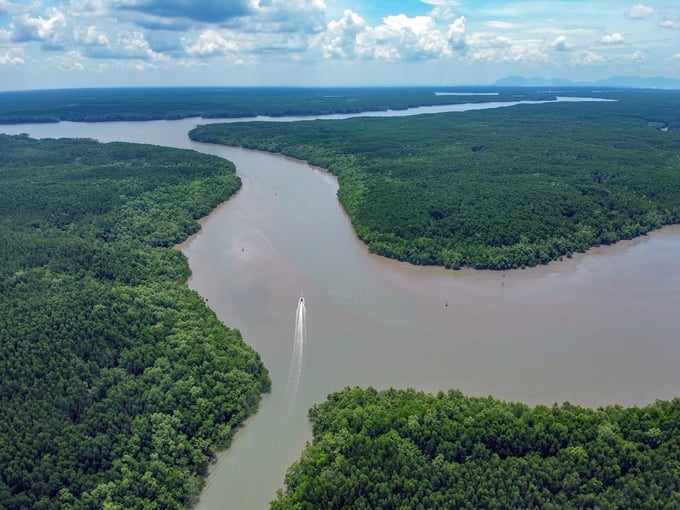November 27, 2025 | 09:05 GMT +7
November 27, 2025 | 09:05 GMT +7
Hotline: 0913.378.918
November 27, 2025 | 09:05 GMT +7
Hotline: 0913.378.918

Can Gio forest as viewed from above. Photo: Can Gio mangrove forest Management Board.
Can Gio Forest was formed and developed on the alluvial ground brought and deposited by the Saigon and Dong Nai river systems. The area gradually formed the ground, combined with the tropical monsoon climate, the semi-diurnal tidal regime, and the dense network of rivers and canals, creating favorable conditions for the development of the mangrove ecosystem.
According to a letter sent to the Ministry of Natural Resources and Environment, the People's Committee of Ho Chi Minh City stated that Can Gio Mangrove Forest meets 4 out of 8 criteria for Ramsar site nomination.
Can Gio mangrove forest contains a sample of unique, rare, and representative natural or near-natural wetland within a biogeographic region. It nurtures extremely endangered, endangered, or vulnerable species, or threatened ecological communities, according to the standards of the International Union for Conservation of Nature (IUCN), with at least 20,000 waterbird individuals. It also provides a crucial food source for fish, acts as a spawning ground, a nursery, and/or a migratory route, enabling fish species to thrive within the wetland area.
With an area of nearly 35,000 hectares of mangrove forest, according to the People's Committee of Ho Chi Minh City, Can Gio Mangrove Forest features diverse and rich ecosystems and serves as a habitat and living space for many valuable wild plant and animal species. It contributes significantly to economic and scientific values, environmental protection, and the stability of the livelihoods of local residents as well as neighboring areas.
Especially, the Can Gio wetland is associated with a restored mangrove ecosystem after the war and was recognized by the United Nations Educational, Scientific and Cultural Organization (UNESCO) as the first Biosphere Reserve in Vietnam.
According to the local authorities, the recognition of Can Gio Mangrove Forest as a Ramsar site will enhance the city's credibility in expanding domestic and international cooperation in the effective management of wetlands. It will increase technical support capabilities, provide international assistance for biodiversity conservation projects and wetland management, and offer advanced training to officials and civil servants in related fields.
The municipal authorities of Ho Chi Minh City have undertaken a comprehensive initiative to transform the Can Gio area into a captivating ecological tourism destination. This transformative effort involves the integration and enhancement of essential infrastructural components such as bridges, roads, canals, and pathways, all leading to the heart of the Can Gio forest. This meticulous approach has been strategically designed to augment accessibility and visitor experiences within this unique ecosystem.
Furthermore, the dedicated management board of the Can Gio forest has spearheaded an array of rigorous research initiatives, strategically aligned to steer the prudent stewardship of natural resources towards the principles of sustainable development and the preservation of biodiversity. Commencing from 1994, a profound responsibility has been entrusted to 144 households and 12 institutional units for the imperative task of safeguarding this invaluable natural enclave. This strategic allocation of responsibility has emerged as a highly effective mechanism in ensuring the protection and longevity of the forest, effectively bearing testament to its success over the course of time.
The transformation of Can Gio into an ecological tourism hub stands as a testament to the municipality's unwavering commitment to sustainable development, biodiversity conservation, and community engagement. This multifaceted initiative endeavors to not only protect the natural riches encapsulated within the Can Gio forest but also to elevate the region into a symbol of harmonious cohabitation between human aspirations and nature's pristine wonders.
According to statistics, at present, Vietnam has 9 Ramsar sites, including Xuan Thuy National Park (Nam Dinh); Bau Sau in Cat Tien National Park (Dong Nai); Ba Be Lake (Bac Kan); Tram Chim National Park (Dong Thap); U Minh Thuong National Park (Kien Giang); Con Dao National Park (Ba Ria-Vung Tau); Lang Sen Wetland Reserve (Long An); Mui Ca Mau National Park (Ca Mau); and Van Long Wetland Nature Reserve (Ninh Binh).
According to the National Action Plan on Conservation and Sustainable Use of Wetlands for the 2021-2030 period, the goal by 2025 is to have 13 Ramsar sites across the country. Ramsar sites in Vietnam emphasize eco-friendly tourism activities and programs, contributing to attracting international attention to wetland conservation. Additionally, they enhance the natural tourism resources of the whole country and Ramsar sites in particular, contributing to socio-economic development.
A Ramsar site is a wetland area that meets the selection criteria of a wetland of international importance, as defined by the Ramsar Convention.
The Ramsar Convention is an international treaty on the conservation and sustainable use of wetlands of international importance, especially as waterfowl habitat. It was signed in 1971 in Ramsar, Iran.
Translated by Nguyen Hai Long
/2025/11/26/4909-2-154329_878.jpg)
(VAN) Pearl grouper farming in HDPE cages not only delivers economic efficiency but also contributes to protecting the environment, creating jobs, and promoting marine-based experiential tourism.

(VAN) The model of making a living under the forest canopy through the agroforestry system in Van Son commune, Bac Ninh province, is expected to generate an annual income of approximately VND 30 million/ha.

(VAN) Many enterprises in Can Tho are harnessing natural energy and reducing greenhouse gas emissions in their production processes, thereby contributing to the promotion of a sustainable green transition.
/2025/11/24/3536-2-112800_176.jpg)
(VAN) Dong Nai now has tens of thousands of hectares of forests certified for sustainable management, and this area will continue to be expanded in the coming period.

(VAN) Vinh Ha hamlet (Dai Xuyen commune, Hanoi) is shifting away from small-scale farming as households adopt bioscurity into their breeder chicken models.

(VAN) Heavy rains make aquatic species more vulnerable to disease. Proactive water management and high-tech systems help farmers prevent outbreaks and protect yields.

(VAN) Greenhouses are shifting production mindsets in Binh Lu commune, enabling farmers to ‘weather the sun and rain’ and secure stable vegetable harvests throughout the year.